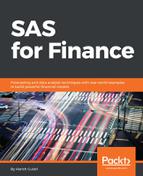We earlier spoke about comparing groups using non-parametric procedures. One of the hypotheses that the business wants to test is whether the risk appetite influences the tenure that the client has. Let's test this using a Strata option.
Here is the code for non-parametric procedure survival by Strata:
PROC LIFETEST Data=Survival_Analysis Plots=survival (strata=panel); Time tenure*censor(1); Strata risk_appetite; Run;
The clients with medium risk have the lowest percent censored population (43.80) across the strata. The highest percent of the censored population (68.92) is for the customers with the riskiest appetite:

At the 20th anniversary, the survival chance of the low (risk appetite=1), medium (risk appetite = 2), and high-risk customers (risk appetite = 3) is around 20%, 12%, and 56%, respectively. This means the higher the customer's risk-taking appetite, the more chances are that they will survive with the brokerage. This insight needs to be further assessed for the reasons that drive this customer behavior. Some of the hypotheses supporting this insight could be that a high-risk customer is getting more returns, tends to have more funds to invest, or this client set is getting more attention and consequently has retained the faith in the brokerage:

But are these three strata statistically similar? To answer this, we can look at the Test of Equality over Strata output in Figure 6.8. The rank tests for a homogeneity highlight that the three Strata are significantly different when evaluating the survival time of clients. Hence, the hypothesis that the business had about the risk appetite influencing the tenure of clients seems validated.
The test of equality over the strata needs to take into perspective the implication of using the Log-Rank, Wilcoxon, and the -2Log(LR) test. Let's assume a scenario where not all three of them are statistically significant. The -2Log(LR) test assumes that the survival curve is exponentially distributed and since that is seldom a case that the analyst experiences, its use is limited. If the later differences in the survival curve are more important for the business problem, then the Log-Rank test is a better judge. If the earlier differences are important then use the Wilcoxon test. If the survival curves of the strata cross at any point, then either of the Log-Rank and Wilcoxon tests is unreliable. But the survival curves in Figure 6.8 don't cross. Well, we have populated them as three separate panel outputs. We need to do a quick check where all three graphs are populated together. If you have 10 strata, this graph will get messy but a quick visual inspection with all the strata on one graph is helpful. The alternative is to go through the survival estimate output diagram:

As we can see from Figure 6.9, our survival plots at a strata level cross between the 5 and 10-year tenure. While choosing graphs, the analyst has to be careful about the repercussions of viewing data in a particular manner. The output also means that the Log-Rank test and the Wilcoxon test aren't reliable.
